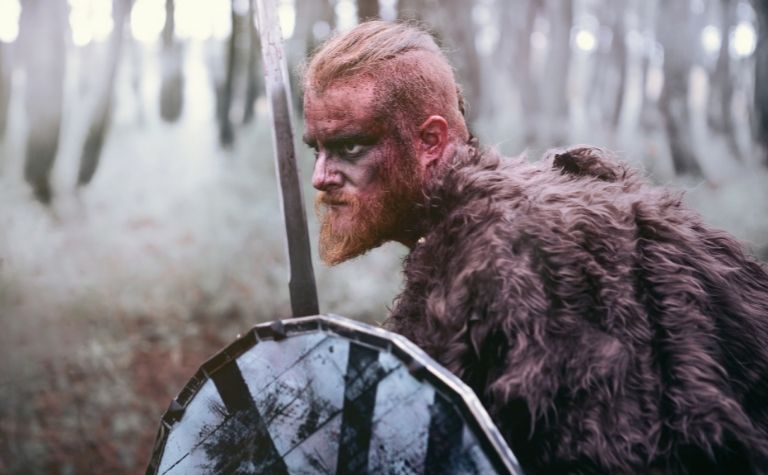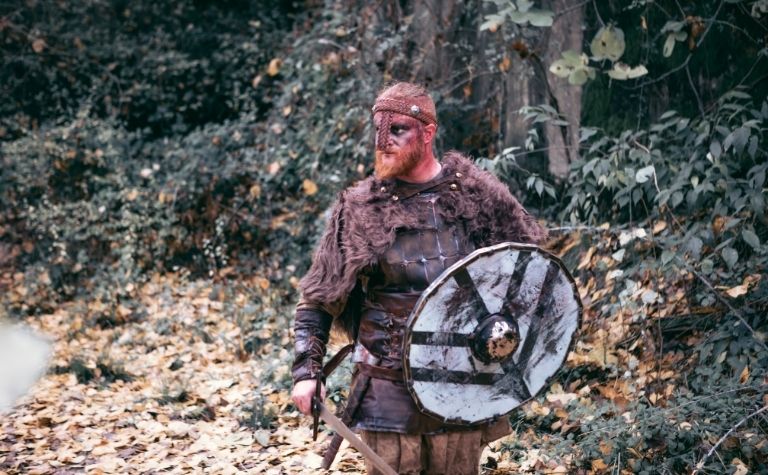The Vikings were famous for their rich culture and ruthless raids on many countries.
They also made some remarkable discoveries, such as finding Greenland.
Viking leaders and kings did all these tremendous acts. So, who are the nine greatest Viking kings and leaders?
The nine greatest Viking kings and leaders are:
- Ragnar Lodbrok
- Cnut the Great
- Erik the Red
- Rollo of Normandy
- Herald of Norway
- Olaf Tryggvason
- Leif Eriksson
- Ivar the Boneless
- Gorm the Old
These leaders and kings are known for their incredible reigns, legacies, and famous discoveries.
All the Viking kings and leaders above had a tremendous impact in their time and on the world today.
Below the legacy of these prominent nine Viking kings and leaders gets expanded.
Also see Were the Vikings Afraid of Anyone? to learn more.

1. Ragnar Lodbrok
Ragnar Lodbrok is probably the most prominent Viking king to have existed. He is of Danish origin and operated during the 9th century.
There is debate about whether Ragnar Lodbrok’s accomplishments got achieved by the one Ragnar or an amalgamation of men.
Ragnar has led very successful raids in Europe, specifically Anglo-Saxon England and France, and has been very ambitious in his accomplishments.
He famously attempted to lead a Viking invasion to England with only two ships.
This act, unfortunately, led him to be captured and his death, around 865 A.D., at the hands of King Aella of Northumbria.
Ragnar is said to be the father of many great Viking leaders, such as Ivar the Boneless.
Ragnar Ladbrok’s story is still prominent today in Viking history.
2. Cnut The Great
Cnut the Great is known to be a great king of England of Viking descent. He is also of Danish origins and operated during the 11th century.
Cnut was the son of Svein Forkbeard, a great king of Denmark.
Cnut helped his father conquer England in 1013 A.D.
His father’s achievement was not entirely successful at first as the exiled Anglo-Saxon English king Aethelred the Unready returned to power in 1014 A.D.
Cnut soon became king in 1016 A.D. after the death of the king and his son’s defeat in the Battle of Ashingdon.
Cnut the Great’s reign over England brought stability to the country’s many years of raids and battles.
His reign did not just extend to England but also to Denmark and Norway.
There is a possibility that Cnut also reigned over portions of Sweden. He died in 1035 A.D. and got succeeded by Harold Harefoot.
Cnut is famous for being a Viking who became a great king of England.
Also see Why Didn’t the Vikings Colonize America? to learn more.

3. Erik The Red
Erik the Red was a renowned Viking leader and explorer who discovered Greenland. Erik the Red was given his namesake as of his red hair.
Erik’s tale starts around 980 A.D. During that period, he was forced into exile from Iceland due to murdering a man.
This act led him to explore the lands that lay to the West, which was Greenland.
Erik the Red dubbed this country Greenland to persuade potential settlers of the country’s rich environments to join him in establishing a settlement.
Erik the Red began the first European settlement on Greenland around 985 A.D.
Erik the Red is known to be an explorer of Viking descent who discovered and established the first European Settlement on Greenland.
4. Rollo Of Normandy
Rollo was a renowned Viking leader who was the ruler and founder of Normandy.
It still gets debated today if he is of Danish or Norwegian origins.
He obtained the piece of land he called Normandy around 911 A.D.
Normandy was given to Rollo of Normandy by King Charles III of France under the Treaty of St. Claire-Sur-Epte.
Charles III gave this Viking leader Normandy to protect his country from vicious Viking raiders.
Rollo went on to later expand his rule over surrounding regions.
Rollo of Normandy is a popular Viking leader who found Normandy.
Also see The Valknut Viking Symbol to learn more.

5. Harald of Norway
Harald of Norway was a prominent Viking king of Norway, reigning from 1045 to 1066 A.D. Harald was of Norway descent.
Herald’s tale began when he was but a fifteen-year-old teenager.
At the time, he attempted to help his half-brother Olaf Haraldsson fight for Norway’s throne from Cnut the Great during the Battle of Stiklestad.
Unfortunately, his half-brother died in battle, and Herald got exiled to Russia.
Herald gained a large amount of power and wealth in Russia and Byzantine.
He later returned to Norway in 1045 A.D. and agreed to rule his home country with his nephew Magnus I Olafsson.
Herald became sole king of Norway in 1047 A.D. after the death of his nephew.
Herald of Norway attempted to expand his rule to England in 1066 A.D.
This attempt led to the defeat of his armies and death in battle.
Herald of Norway is known to the king of his home country Norway from which he got formally exiled.
Also see What Country Has the Most Viking Heritage? to learn more.
6. Olaf Tryggvason
Olaf Tryggvason was a popular Viking king of Norway who brought Christianity to the country under his rule to replace the Viking’s pagan beliefs. He reigned from 995 to 1000 A.D.
His road to eventually becoming Viking king of Norway began in 991 A.D. after spending many years from childhood in Russia.
There Olaf Tryggvason was trained as a Viking warrior.
In 991 A.D., he assisted in the Viking attacks on England.
King Ethelred II of England attempted to make peace with the Vikings by paying large sums of tribute to stop their attacks.
Despite King Ethelred II’s attempt at negotiating peace with the Vikings, Olaf invaded England again in 994 A.D. with the help of Danish King Sweyn I Forkbeard.
King Ethelred II again asked for peace by paying large sums of tribute. Ironically, afterward, both Olaf, who had converted to Christianity, and Ethelred II were shortly after that confirmed together in 994 A.D.
Olaf returned and became king of Norway around 995 A.D. after the growing revolt and death of Norway King Haakon the Great.
There he forcefully imposed Christianity where he controlled.
Olaf Tryggvason was famous for being the first Viking Christian King.
7. Leif Eriksson
Leif Erikson was a renowned Viking explorer known as one of the first Europeans to arrive in North America.
Leif’s discovery of North America occurred around 1000 A.D., around 500 years before Columbus set foot on North America.
Leif Eriksson was one of the sons of the famous Viking explorer Erik the Red.
He stumbled upon North America while sailing around 1000 A.D. from Greenland to Norway, under the order of King Olaf Tryggvason, to spread Christianity to Greenland.
Leif Erikson stumbled off his course and landed in North America during the trip.
He found extraordinary building-like structures made of timber and great produce of grapes on the land.
Leif Erikson dubbed the region Vinland because of North America’s grapes.
Leif Eriksson is a famous Viking explorer known for setting foot on North America in 1000 A.D., around 500 years before Columbus.
Also see Viking vs Anglo-Saxons: Comparison to learn more.
8. Ivar the Boneless
Ivar the Boneless was a ruthless Viking chieftain and one of the sons of Ragnar Lodbrok.
Like Ragnar Lodbrok, his father, there is much debate about whether he existed or not.
Ivar the Boneless is famous for his brutal torture and military tactics, which became synonymous with the cruelty of the Vikings, and for invading Great Britain in 865 A.D.
Ivar the Boneless invasion of Great Britain at the time was also an act of revenge on King Aella, the king of England, who killed his father, Ragnar Lodbrok.
There is a rumor that King Aella was killed by Ivar the Boneless through the horrific Blood-eagle torture.
Ivar the Boneless was a Viking chieftain whose methods became synonymous with the Viking’s cruelty and also one of the sons of the famous Ragnar Lodbrok.
9. Gorm the Old
Gorm the Old was a Viking king of Denmark who ruled Denmark from 936 A.D. to his death in 958 A.D.
Gorm the Old was one of the oldest Viking kings of Denmark, reigning from 936 A.D. until his death in 958 A.D. He was also the head of the ancestral Danish Monarchy.
Conclusion
The nine greatest Viking leaders were known for their incredible legacy in Viking culture, extraordinary discoveries, reign over countries and settlements, and vicious and cruel war tactics.
The nine greatest Viking kings and leaders are Ragnar Lodbrok, Cnut the Great, Erik the Red, Rollo of Normandy, Herald of Norway, Olaf Tryggvason, Leif Eriksson, Ivar the Boneless, and Gorm the Old.
Also see Were There Dutch Vikings? to learn more.
